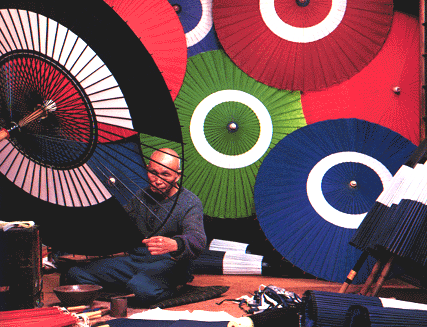
Introduction to WAGASA (traditional Japanese umbrella)
Various natural materials, such as bamboo, kozo, cashew and tapioca, are transformed into Wagasa through the hands of more than 10 highly experienced craftspeople. With its production process being one of the most complicated of all handcrafts (more than 100 steps!), it usually takes months to make a good Wagasa. Here, we would like to introduce the production process of Authentic Janome, high quality rain umbrella.
First of all, quality paper is required for Authentic Janome. Kozo(paper mulberry) is boiled, beated, watered and hand-made into paper without additonal pulp fibers. Long and strong fibers of Kozo make Janome strong and waterproof (with some help from plant oils) Looking through Janome against sunlight, you will see vague short lines all over it. This is the proof that the paper is hand-made.
Then, bamboo must be cut into slim sticks which compose the frame of Janome. Usually, bamboo is cut into 48 even pcs. Since umbrella must be folded, subtle allowance must be made to cut off certain parts of each bamboo frame. Only with the help from experienced bamboo craftsman, we can create good Janome which can reminds users of original shape of the bamboo.
Papering Wagasa may look simple, but it requires minute technique since paper must be folded nicely after it is pasted on the frame. Inadequate papering not only spoils the elegant look of Wagasa, but also puts stress on the paper as it is repeatedly used, shortening its life. It even twists the umbrella sometimes. Years of experience is usually needed just to paper strong and straight Janome. Only the best craftspeople can create elegance of Authentic Janome.

Master paperer Ban at work
Since even the strongest natural papaer is not waterproof, mixture of various plant oils are applied on Janome. After being sun-dried for several days, Janome becomes rain gear. However, it is not scratch-proof yet. So after it is folded, cashew laquer is applied on the surface of each papered bamboo stick. It is one difficult task to put adequate amount of oil on the papar; It is another to apply cashew laquer only on the surface of folded Janome without letting it spread into inside, spoiling the whole work.
Other than these, there are various works to be done. Bamboo sticks are usually dyed, and connected together into a frame before being covered by selected pieces of paper with same thickness. At the finishing stage, decorative thread is attached through the frame and rattan is wound around the handle. Ironically, there are so many independent manufacturing steps that it's very difficult to have young people engage in Wagasa production. While preserving the tradition of Wagasa, we may have to modify the production process so that craftspeople can appeal themselves making use of ones' own creativity.